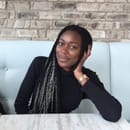I have vivid childhood memories of my sitting on the floor or on a chair while someone – usually my mom or my aunt – yanking and tugging at my dark, curly hair. I’d wince, complain and cry.
“Tender-head” is what they’d call you if you couldn’t stomach the pain. After 20 minutes of ‘beauty is pain’ suffering, I’d hesitantly look in the mirror and my stomach would drop. Big, voluminous hair in twists, braids, bubbles or beads. Why couldn’t she just straighten my hair? Why couldn’t my hair be like my friends’? Discontent with my “ethnic” hairstyles, I’d finick with my hair throughout the day, going back home looking worse than how I left. Dreaded were wash days spent bent over sinks and bathtubs, detangling the inescapable knots in my hair.
When my mother was in school in Jamaica, a British colony until the 1960s, hair was fiercely regulated. No braids, no dreads. These styles were “too black” for colonial Jamaica. It’s comic that dreads were perceived that way, considering their cultural connection to Jamaican Rastafarians. It’s worth noting, though, that despite their cultural importance there, dreadlocks aren’t exclusive to Jamaicans. Still, they are a fierce part of black identity and symbolise more than just a hairstyle and an affinity to reggae music. The 80s and 90s on the Caribbean island saw styles like Gerry curls and perms more than anything. Both styles anchored on chemical hair relaxers to make our kinky hair more manageable.
My mother remembers these hairstyles being barred at her strict uniform school, so she never experimented with her hair. She remembers wearing braids once, during summer vacation. Her dad’s sister, my great aunt Denise, did it. When September rolled back around, she had to take them out and conform, once again, to her colonial dress code.
Trained to tame and suppress her God-given hair, my mom was not interested in learning how to nurture and style her hair. French braids and cane rows (what we Caribbeans affectionately call cornrows) were popular options. Whatever was easy and Western was the way to go. My mom kept her hair short and permed.
It makes sense why my mom was never interested in learning how to do my hair. “I couldn’t bother,” my mom said when I asked her. “I didn’t want to style hair.” When I was a child, I would sometimes get braids, prompting Alicia Keys comparisons from my non-black friends. When I was 10 or 12 my mom permed my hair, a chemical process that can severely damage an individual’s natural hair pattern. For a while, I loved it. Finally, I thought. Straight, flat and lifeless hair.
Eventually, I switched to braids. Uniformity and plainness are what I sought for my hair. Still, black hair was something that seemed to irk everyone. Afros, durags, dreads, and cornrows seemed to be a problem. I longingly looked to my mixed or Eastern African friends who were complimented on their curly-but-manageable hair, and glanced up at my coarse, coily hair.
Surely this wasn’t “good” hair. Even under intricate and delicate braids, questions from strangers about my hair constantly circled me: Is that real? Is that plastic? Can I touch it? How short is your hair under there? Would it hurt if I pulled one? Can I cut one off? I eventually learned that these questions didn’t stem from curiosity or genuine interest. These were micro-aggressions, rhetorical questions embedded in stereotypes, misconceptions and “jokes” about hair like mine.
It took me coming to university to start loving my hair. To appreciate her kinks and coils. To observe the way she shrinks and hides length and stretches to reveal fullness, volume, and body. To admire how full of life she was. To love the way she defies gravity, constantly reaching towards the sky. To adore the braids, plaits, puffs, dreads, silky tresses and the other infinite possibilities. She is so versatile, so strong, so powerful.
Last December, I decided to skip my beloved braids and embrace the head of dark brown hair I was blessed with. I went to the hair store – for hair like mine – and bought combs and brushes and hair clips and barrettes, excited to experiment with my natural hair. Frustrated at first, I tugged at and toyed with my hair, begging my mom to help me. Sitting there on the living room floor, I felt like a kid again. Ow, I kept saying, cursing my ever-tender scalp. Still, I smiled, soaking in the quiet, close moment with my mother. There is no moment more cherished than a mother brushing her daughter’s hair. As I sat there, I started thinking about this piece, this love letter I’d pen to my precious hair.
This is a love letter to my beautiful, black hair. Happy Valentine’s Day, hair. Continuing growing and thriving, onward and upward.



